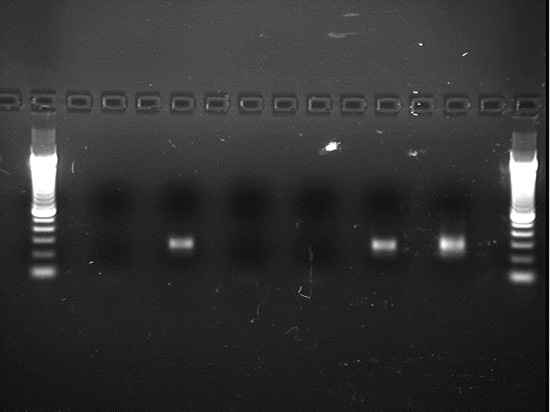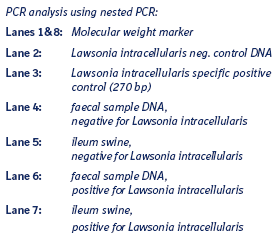5.1.6 PCR analysis of pig faeces for Lawsonia intracellularis
Successful and specific PCR assays have been developed using primer pairs derived from various portions of the DNA sequence of porcine Lawsonia intracellularis. Use of the PCR on faecal samples requires considerable attention to the details of proper extraction methods so that bacterial DNA free of inhibitory substances is used as the template DNA for the PCR. The PCR has the advantage of determining whether a pig is suffering a current active infection. However, it has the disadvantage of being more expensive and of low sensitivity in sub clinical and chronic disease.
Principle of the test:
DNA is extracted from faecal samples or organ material. Using DNA preparation kits that are commercially available usually improves quality and reproducibility of the DNA extraction. DNA can be stored at -20°C before further processing. Primer sets specific for Lawsonia intracellularis are used to amplify genomic fragments that can be visualized in real time PCR by labelled detection primers or in an agarose gel electrophoresis by DNA staining (ethidiumbromide, e.g.). Contamination of the diagnostic material during sampling, transport or processing, as well as cross contamination during amplification, can result in false positive results. The risk of cross contamination increases significantly in the two step nested PCR, which is 100 – 1000 times more sensitive than the normal one step PCR. PCR should be limited to laboratories which are experienced in this method and are able to process large numbers of samples for molecular biological diagnosis.

Picture. 5.1.6 a (by V. Ohlinger)
Two step (nested) PCR (nPCR) for the detection of Lawsonia intracellularis.

Special equipment:
Centrifuges for DNA preparation, heating blocks and thermocyclers are necessary for the propagation of PCR’s. Strictly separated locations for distinct PCR steps or non-cross contaminating (ncc) equipment are highly desirable, especially in case of nested PCR.
Result format:
Detection of Lawsonia intracellularis – specific PCR products in real time PCR or of fragments with an appropriate estimated size in Gel electrophoresis are concidered positive. Positive means that genomic DNA of Lawsonia intracellularis was detected. However, a positive PCR result does not necessarily indicate that the bacterium is still alive and replicating. Nevertheless, mRNA assays reveal that positive PCR results from infected animals usually correlate with infectivity.
Note: The DNA of field and vaccine isolates can not be differentiated using currently available PCR techniques.
© Boehringer Ingelheim Animal Health GmbH, 2006
All rights reserved. No part of this Technical Manual 3.0 may be reproduced or transmitted in any form or by any means, electronic or photocopy, without permission in writing from Boehringer Ingelheim Animal Health GmbH.






